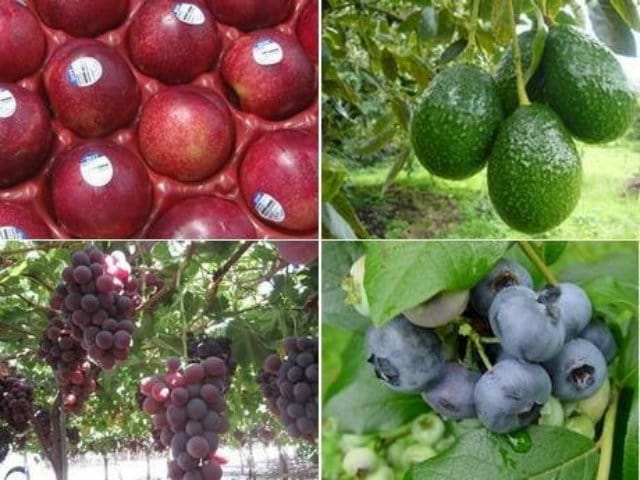
SANTIAGO – Chile exported about $1,200 million dollars of fresh fruit to China in 2016, replacing Thailand as the largest supplier of fresh fruit for China.
According to data released by the Chinese Customs, in 2016, the country supplied fruit 22 percent more than in the previous year.
China’s fruit demand has grown strongly, and Chile has the advantage of offering fruit in the off season.
What’s so special about Chilean fruit?
The Chilean fruit industry was born in the 60s, and after decades of development, it currently produces more than 130 varieties of fruit each year. The country exports more than 2.4 million tons of fruits and vegetables to 80 countries and regions of all the world. The fruit industry accounted for almost 40% of the country’s total agricultural production, providing about 450,000 jobs a year.
Today, Chile is the largest fruit exporter in the southern hemisphere, and the largest exporter of grapes and plums in the world. Chilean fruit exports to China increased in recent years. In 2007, they accounted for less than 2% of Chile’s total exports, but last year they accounted for 25%. The three most exported fruits from Chile to China were cherries, grapes, and plums.
“Ten years ago we wouldn’t have dreamed of becoming China’s largest supplier of fruit. At that time we believed that Thailand was almost impossible to overcome,” said Luis Schmidt, the president of the National Trade Federation of Producers of fruits and former Chilean ambassador to the People’s Republic of China.
However, in 10 years, fruit exports from Chile to China increased from 67 million dollars in 2007 to 1,262 million in 2016, i.e. almost 19 times.
Thailand was, for many years, China’s biggest supplier of fruit because of multiple reasons, such as the short distance between the two countries, Thailand’s short harvest period, and because of the abundance of some types of tropical fruits that the country has.
Schmidt said fruit exports from Chile to China have grown rapidly, mainly due to the huge demand of the growing Chinese market. In the past 10 years, China’s demand for food imports, including fruits, increased by 10%. If we consider the steady growth of the middle class in China, demand for high quality fruit will continue. As a result, Chile will undoubtedly become an excellent supplier.
Chilean fruit, which has a high quality, is very convenient for the Chinese market as Chile’s supply comes out in the counter season, as winter in the northern hemisphere coincides with summer in the southern hemisphere. Thus, it compensates the lack of fruit in China’s offseason.
The harvest season of the Chilean cherries, for example, takes place between November and January, which coincides with the Spring Festival in China. As a result, despite having entered the Chinese market in 2010, last year they were Chile’s most exported fruit to China, to the point that Chile sent 85% of its domestic production of cherries to that country.
In order to export fresh cherries in time for the Spring Festival, China Eastern Airlines has arranged special flights to transport the cherries.
After the signing of the Free Trade Agreement between China and Chile, the Chilean fruit sector enjoyed a 13% tariff reduction.
In 2006, China and Chile began to formally implement the Free Trade Agreement, according to which 97.2% of total goods traded between the two countries will be tariff-free in a period of 10 years. Chen Jianhua, the secretary of the president of Joy Wing Mau Group, said that, after the signing of the FTA between China-Chile, the Chilean fruit entering China is exempt of a 13% tariffs thanks to preferential policies, which has decreased the price of Chilean fruit and increased its profit margin, which in turn intensifies competition in the market.
Last month the first batch of nectarines exported from Chile arrived in China. As agreed in the agreement signed between the two countries last year, Chile became a new supplier of this type of fruit to China. “We hope that the Free Trade Agreement includes more varieties of Chilean fruit in the future, and that Chilean exports to China amount to 4 billion dollars in three or four years,” Schmidt said.
In recent years, several Chinese companies have actively participated in the trade of Chilean fruit. In 2013, the Joy Wing Mau Group acquired five fruit orchards where they cultivate grapes, kiwis, and blueberries.
Chile is the first place abroad where the Joy Wing Mau Group has purchased fruit orchards. The company chose Chile because of its developed fruit industry and because of the cost of the investment. “Fruit is a special agricultural industry, and the harvest largely depends on labor,” said Chen Jianhua, adding that the Chilean workers’ wages in this sector is a tenth of what Australian workers receive for the same job.
The kiwi harvest season started in an orchard that is two hour away from Santiago, Chile’s capital. “These kiwis will be sold in the local market. The ones that are exported to China have already been collected,” said Claudio, the orchard’s manager, adding that their orchard’s area amounted to 2000 mu (1,332,000 m2) and that they had an average yield of about 2 tons per mu (1 mu equals 666 m2).
The kiwi orchard uses advanced technology to grow the fruit. The fruit is separated and classified by size so they can perform better irrigation and fertilization; the soil’s moisture is monitored at all times with depth and humidity sensors up to 1.5 meters deep and every 30 cm.
These sensors have data collection devices, which are synchronized at all times with the phone of the person responsible for overseeing the data.
If the humidity is lower than the predetermined value, the drip system starts working automatically.



